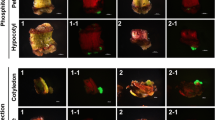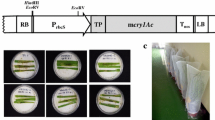Abstract
Transgenic cells containing inserted antibiotic resistance genes and linked genes of interest are routinely selected by exposure to antibiotics. Concerns over the widespread use of antibiotic resistance genes as selectable markers for genetic transformation have motivated researchers to find alternative selection procedures. This study describes the evaluation of an alternative protocol using temperature as the selection tool. In this method, a population of host cells is transformed with a foreign DNA construct that includes at least one gene of interest and an additional sequence encoding a protein that enhances cellular high temperature tolerance. Following transformation, the population of cells is transiently cultured under temperature conditions wherein growth of non-transformed cells is suppressed or prevented, while growth of cells containing the DNA construct continues. Thus, survival and/or significant additional growth is an indication that a cell has been successfully transformed with the DNA construct and can be subsequently recovered for further growth and development. The present study used a heat shock protein (hsp101) gene from Arabidopsis thaliana under the control of a constitutive promoter as a selectable marker; however, alternative potentially suitable genes include: other heat shock proteins; heat shock transcription factors; cold regulated proteins (COR); or protein transcription factors associated with the induction of cold tolerance.







Similar content being viewed by others
References
Bayley C.; Trolinder N.; Ray C.; Morgan M.; Quisenberry J. E.; Ow D. W. Engineering 2,4-D resistance into cotton. Theor. Appl. Genet. 835: 645–649; 1992.
Bretagne-Sagnard B.; Chupeau Y. Selection of transgenic flax plants is facilitated by spectinomycin. Transgenic Res. 5: 131–137; 1996.
DeBlock M.; Botterdam J.; Vanderwiele M.; Dockx J.; Thoen C.; Gossele V.; et al. Engineering herbicide resistance in plant by expressing a detoxifying enzyme. EMBO J. 6: 2513–2518; 1987.
DeBlock M.; Brouwer D. D.; Tenning P. Transformation of Brassica napus and Brassica oleracea using Agrobacterium tumefaciens and the expression of the bar and neo genes in the transgenic plants. Plant Physiol. 91: 694–701; 1989.
Fraley R. T.; Rogers S. G.; Horsch R. B. Genetic transformation in higher plants. Crit. Rev. Plant Sci. 41: 1–46; 1986.
Fromm M. E.; Morrish F.; Armstrong C.; Williams R.; Thomas J.; Klein T. M. Inheritance and expression of chimeric genes in the progeny of transgenic maize plants. Biotechnol. 8: 833–839; 1990.
Gamborg O. L.; Miller R. A.; Ojima K. Nutrient requirements of suspension cultures of soybean root cells. Cell Res. 50: 151–158; 1968.
Hille J.; Verheggen F.; Roelvink P.; Franssen H.; Kammen A. v.; Zabel P. Bleomycin resistance: A new dominant selectable marker for plant cell transformation. Plant Mol. Biol. 73: 171–176; 1986.
Hood E. E.; Gelvin S. B.; Melchers L. S.; Hoekema A. New Agrobacterium helper plasmids for gene transfer to plants. Transgenic Res. 2: 208–218; 1993.
Jayne, S.; Barnour, E.; Mayer, T. Methods for improving transformation efficiency. U. S. Patent 6,096,947. 2000.
Jones J. D. G.; Svab Z.; Harper E. C.; Hurwitz C. D.; Maliga P. A dominant nuclear streptomycin resistance marker for plant cell transformation. Mol. Gen. Genet. 210: 86–91; 1987.
Katiyar-Agarwal S.; Agarwal M.; Grover A. Heat-tolerant basmati rice engineered by over-expression of hsp101. Plant Mol. Biol. 51: 677–686; 2003.
Li Z.; Murai N. Agronomic trait evaluation of field-grown transgenic rice plants containing the hygromycin resistance gene and the maize activator element. Plant Sci. 108: 219–227; 1995.
Lindquist, S. Methods and compositions of genetic stress response systems. U. S. Patent 5,827,685. 1998.
Meijer E. G.; Schilperoort R. A.; Rueb S.; van Os-Ruygrok P. E.; Hensgens L. A. Transgenic rice cell lines and plants: Expression of transferred chimeric genes. Plant Mol. Biol. 16: 807–820; 1991.
Moisyadi S.; Harrington H. M. Characterization of the heat shock response in cultured sugarcane cells: I. Physiology of the heat shock response and heat shock protein synthesis. Plant Physiol. 90: 1156–1162; 1989.
Murashige T.; Skoog F. A revised medium for rapid growth and bioassays with tobacco tissue cultures. Physiol. Plant 15: 473–497; 1962.
Ni M.; Cui D.; Einstein J.; Narasimhulu S.; Vergara Q.; Gelvin S. Strength and tissue specificity of chimeric promoters derived from the octopine and mannopine synthase genes. Plant J. 7: 661–676; 1995.
Nover L.; Scharf K. D. Heat stress proteins and transcription factors. Cell. Mol. Life Sci. 53: 80–103; 1997.
Queitsch C.; Hong S. W.; Vierling E.; Lindquist S. Heat shock protein 101 plays a crucial role in thermotolerance in Arabidopsis. Plant Cell 12: 479–492; 2000.
Schoffl F.; Prandl R.; Reindl A. Regulation of the heat-shock response. Plant Physiol. 117: 1135–1141; 1998.
Toki S.; Takamatsu S.; Nojiri C.; Ooba S.; Anzai H.; Iwata M.; et al. Expression of a maize ubiquitin gene promoter-bar chimeric gene in transgenic rice plants. Plant Physiol. 100: 1503–1507; 1992.
Vierling E. The roles of heat shock proteins in plants. Annu. Rev. Plant Physiol. Plant Mol. Biol. 42: 579–620; 1991.
Waldron C.; Murphy E. B.; Roberts J. L.; Gustafson G. D.; Armour S. L.; Malcolm S. K. Resistance to hygromycin B. A new marker for plant transformation studies. Plant Mol. Biol. 52: 103–108; 1985.
Walker-Peach C.; Velten J. Agrobacterium-mediated gene transfer to plant cells: Cointegrate and binary vector systems. In: Gelvin S. B.; SchilperoortR. A.; VermaD. P. S. (eds) Plant molecular biology manual. Kluwer Academic Publishers, The Netherlands, pp 1–19; 1984.
Xin Z.; Velten J. P.; Oliver M. J.; Burke J. J. High-throughput DNA extraction method suitable for PCR. Biotechniques 34: 820–824, 826; 2003.
Zimmerman, J. L.; Slovin, J. P.; Malik, M. K. Thermotolerance enhancing protein. U. S. Patent 5,922,929. 1999.
Acknowledgments
The author thanks Jacob Sanchez, Marie Syapin, Brian Sanderson, and Dee Dee Laumbach for their excellent technical assistance. Mention of a commercial or proprietary product does not constitute an endorsement by the USDA. USDA offers its programs to all eligible persons regardless of race, color, age, sex, or national origin.
Author information
Authors and Affiliations
Corresponding author
Additional information
Editor: Charles L. Armstrong, Ph.D.
Rights and permissions
About this article
Cite this article
Burke, J.J., O’Mahony, P.J., Oliver, M.J. et al. A selection procedure for identifying transgenic cells and embryos of cotton without the use of antibiotics. In Vitro Cell.Dev.Biol.-Plant 44, 246–253 (2008). https://doi.org/10.1007/s11627-008-9133-2
Received:
Accepted:
Published:
Issue Date:
DOI: https://doi.org/10.1007/s11627-008-9133-2




